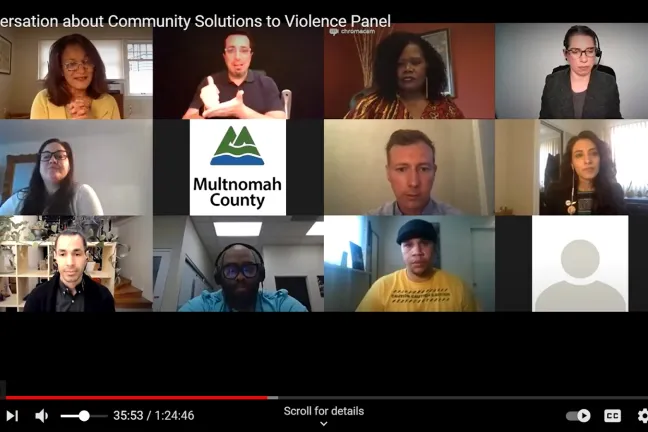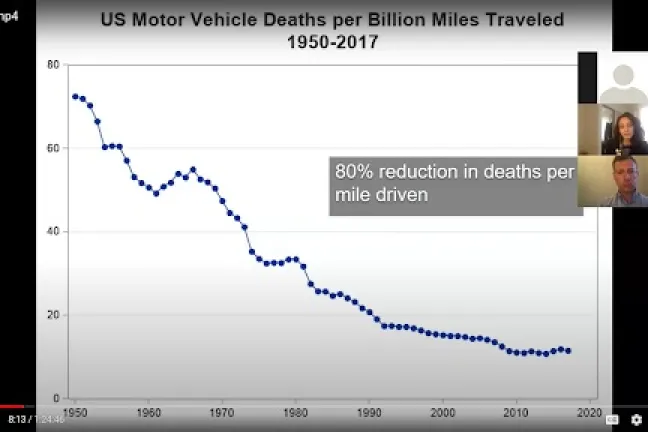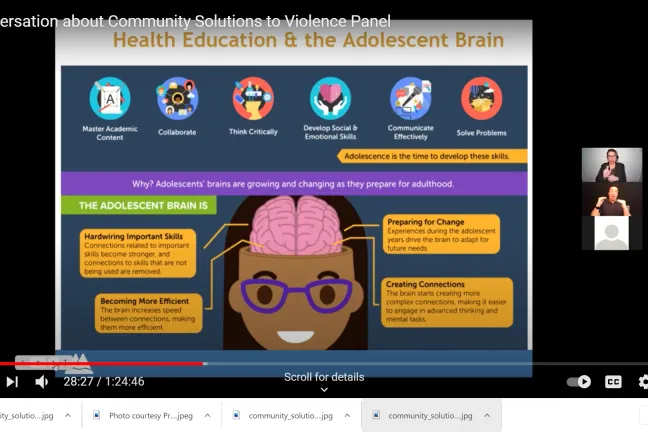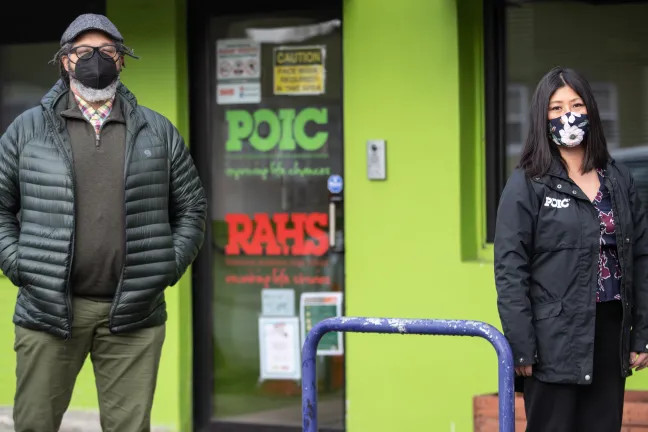More than 140 people joined County, community and national experts on Friday, March 19 for a critical conversation on escalating gun violence in Portland and across the nation.
The virtual assembly, hosted by Multnomah County Commissioner Susheela Jayapal, brought together local expertise from Multnomah County Public Health, the County’s Department of Community Justice and Portland’s Office on Violence Prevention as well as national experts from Boston University School of Public Health, Everytown for Gun Safety and the Giffords Law Center to Prevent Gun Violence.
The discussion provided context on the recent sharp rise in gun violence in Portland and across the nation, and identified strategies and solutions to suppress it.
Planning for the panel started weeks ago, said Commissioner Jayapal, who opened the meeting with a moment of silence to honor each of the eight people — six of whom were women of Asian descent — killed in Atlanta, Georgia just days before the event.
Within three days of the panel discussion, yet another mass shooting claimed 10 lives in Boulder, Colorado after a gunman opened fire in a grocery store.
“As many of you know, violence in Multnomah County and across the nation is on the rise,” Jayapal said. “As of March 8, this year has seen approximately 250 shots fired in Portland, 17 of which resulted in a death.”
But the numbers obscure the people behind them, she continued.
“Violence tears apart families, neighborhoods, and communities,” said Jayapal. “It has ripple effects that can continue for generations.”
Much of the focus around the spike in violence has been on the police response, she said. “But if we’re going to treat gun violence as the public health issue that I believe it is, we also need to talk about — and invest in — community-based strategies for preventing and responding to violence.
That’s the conversation I’m looking forward to having this afternoon.”
Gun Violence as a Public Health Crisis
Each speaker provided snapshots of strategies used to prevent gun violence, from hospital-based interventions to community outreach programs, to improvements in physical spaces and environments.
“Our best public health successes look like this,” said Dr. Jonathan Jay, an assistant professor at Boston University School of Public Health, pointing to a chart of motor vehicle deaths per miles driven, which dropped 80 percent from 1950 to 2020.
Before 1950, we focused on the individual driver: who’s a good driver, who’s a bad driver, how we persuade people to drive better, said Jay.
“That didn’t work.”
Instead, we built better data systems and developed a better understanding of environmental conditions, inside and outside vehicles, that contribute to fatalities. Jay gave the example of a rumble strip, which wakes up dozing drivers.
“In the event you can’t avoid a collision, cars have gotten so much safer.”
There’s very little evidence that we improved motor vehicle fatalities by improving drivers, he stressed. “We didn’t. We improved it by making the environment safer,” Jay said.
The criminal justice system’s response to violence has been similar to that early concern about motor vehicle death focusing on, “Individuals who are bad and who need to change,” said Jay.
“But what we know in a public health approach is that ‘hurt people, hurt people’. Victimization and perpetration are part of a cycle that starts with exposure and progresses.”
A public health approach to violence recognizes that cycle and interrupts it. Some interventions associated with reductions in gun violence can include:
Hospital-based interventions and trauma-informed care immediately after injury
A full set of services from job opportunities and educational opportunities after an event
Outreach workers who connect with the community where violence has occurred.
Even changing neighborhoods and physical spaces can help. In Philadelphia, vacant lots full of trash were turned into simple, small parks, said Jay. Similar practices, known as place-making strategies, are also used in Multnomah County.
“When spaces feel safer, when they’re more welcoming, people get out on the street. They get to know each other and; communities are stronger and safer,” said Jay.
Gun violence is complex. It calls for a range of solutions that should be paired with interventions at every level, he shared.
Since 2018, gun violence has reached alarming levels per capita, across U.S. cities. In 2020, youth of color in Multnomah County were substantially more likely to live in a census tract neighborhood where there was at least one gun homicide — double the rate of exposure as white children ages 5 to 17. Asian American children and Black children faced the highest exposure of all.
Dashboards that provide data in real time can measure disparities and other inequities, he said.
“Every locality should set ambitious, achievable targets for reducing gun violence and hold themselves to it,” he ended. “And doing it a public way that allows communities to track progress and call for resources.”
Listen to the full discussion here.
Upstream Work
Multnomah County Public Health uses an upstream approach to address violence, said Sarah Fast, a manager for Multnomah County’s Community and Adolescent Health Program.
As an illustration, she asked attendees to imagine two people fishing on a riverbank who see someone coming down the river struggling to stay afloat. They immediately jump into action and bring the person ashore. Then they see another person, and another.
They travel upstream and see a cliff with a beautiful view that people are leaning over to observe and falling into the river.
The two observers’ efforts were reactive at first. But then they thought about what they could do to prevent people from falling into the river in the first place. They placed a sign explaining the risks, put up a fence and put in a bench to make it accessible and safe.
The Community and Adolescent Health program works in the same way, Fast said.
“We aim to prevent chronic disease, violence, injuries and improve sexual health and the health and relationships of young people and adults,” she said.
In the river analogy, educating people about the risks or teaching them to swim before they reach the viewpoints puts them in less danger.
Similarly, the Community and Adolescent Health program aims to intervene in ways that puts community members in less danger of violence. It serves a significant role in chronic disease prevention and health promotion and they serve as key factors in improving people’s mental, physical, emotional and social health.
Middle school and high school are a time of transition into adulthood, said Fast. It’s a critical window for human development and learning.
“It’s also a natural time for risk taking, identity forming and identifying social places,” said Fast.
“Culture and learning environments inside and outside school, and online, affect learning opportunities that adolescents experience, and their development and capacity to learn.”
Supporting students at this age is vital. Through its Community and Adolescent Health program, Multnomah County provides comprehensive health education and helps youth identify the risks and outcomes of behaviors like skipping class, engaging in sexual activity, and drug and alcohol use.
“We also help young people build up social and emotional skills to navigate the world and make healthy choices.”
Interventions Downstream
By the time someone reaches Multnomah County’s Department of Community Justice (DCJ), which oversees parole and probation, juvenile detention, juvenile services and pretrial services, they are further downstream in the criminal legal system.
DCJ provides supervision of youth and adults, but the work goes much further by providing connections to resources and services for youth, adults, families, and communities to address the underlying issues that drive crime, explained DCJ Director Erika Preuitt.
“Our vision is community safety through positive change,” she continued. “But we also have to acknowledge the historical racism, system issues and disparities that we inherit and, in some ways, where we perpetuate them.
“We are a department that holds ourselves accountable because we know the interest of public safety is a long-term sustainability of community safety.”
The recent surge in gun violence and deaths is excruciating. And the data shows the violence affects Black, Indigenous, Asian and other communities of color at a higher rate.
“We have juvenile court counselors who deeply care because they work with these people,” said Preuitt. “But time in our system is finite. So it’s really how we wrap ourselves around families.”
As part of a holistic response to gun violence, DCJ is working closely with Public Health and community partners, said Preuitt. A notable partnership is with the Community Healing Initiative (CHI), a program tailored for youth of color involved in the juvenile system, and their families.
Through CHI, the department works with Portland Opportunities Industrialization Center and Latino Network, two culturally specific community-based organizations, to provide everything from parenting connections and mentorship to rent, utilities, internet access and laptops.
Soon, that work will expand to the African refugee and immigrant community.
“What we’re most proud of is giving our parents a voice and ensuring they can advocate for the needs of their family and pushing us to give support to families that they need,” Preuitt said. “That’s collaboration across cultures to support youth and each other and create safe communities.”
Solutions
Other speakers included frontline workers in violence prevention programs, including Mustafa Washington with Portland’s Office of Violence Prevention and Roy Moore of Healing Hurt People.
Portland’s Office of Violence Prevention provides a medley of programs including street level outreach, hospital-based interventions, and services for families and people most susceptible to violence.
During and after shootings, the Office of Violence Prevention fills spaces with good energy, said Washington.
Healing Hurt People, a hospital-based trauma intervention program, provides critical interventions including referrals and resources for intentional trauma, such as gun and stabbings incidents.
Evidence shows that if you can get to a person within a four-hour window of being admitted to a hospital after serious injury, they are more likely to change their mind about their life course, Washington said.
“I’ve seen people sitting in hospital beds and that bullet is hot and eating your flesh,” said Washington. “I’m pretty sure you’re going to change your mind and want to navigate your life and do something different.”
The Office’s Trauma and Violence Impacted Family program works to break the family cycles associated with violence. It pairs people with mentoring and mental health services, as well as immediate resources such as gas, food and sometimes relocation, if needed.
And Street Level Outreach workers build relationships with youth and their families. The office is also working to bring in more park rangers at local parks.
“Full disclosure, I’m a former gang member and violence has affected me,” said Moore. “I understand what it’s like to be in that bed when you have officers, doctors and nurses asking questions.
A lot of times you just need a person to say, ‘What can I do for you?’” That’s when I come in and provide support, advocacy and get you to make different decisions.”
Community involvement and giving back are paramount to addressing violence.
“As long as bullets are flying, none of us are safe,” Moore said.
Mike Meade, director of government affairs for Everytown for Gun Safety, the largest gun safety organization in the nation fighting for gun safety laws, said frontline workers supporting people and families impacted are essential and should be supported, along with investments in intervention models at the federal, state and local levels. And law enforcement, community-based organizations, elected leaders and community members must all coordinate in response, he stressed.
The final speaker, Brittany Nieto of Congresswoman Gabrielle Giffords Law Center to Prevent Gun Violence, cited, among many examples, evidence-based strategies to address group violence.
Oakland, California saw a 50 percent reduction in gun violence over six years by employing a repeated group violence intervention strategy, Nietto said.
“It begins with a problem analysis to narrowly target resources towards the highest risk population,” said Nieto. Once that population is identified, they’re brought in for a call-in with social service providers, community groups and law enforcement, she said. The message is conveyed that the community wants to see you alive and safe. But the shootings must stop.
“What are the essential elements to pulling the strategies together and making sure they have impact?” asked Commissioner Jayapal of panelists.
“We lack a schematic of all of our assets,” said Preuitt.
“I think next steps for us is a collective perspective of what’s happening across so many communities in Multnomah County, seeing what that looks like in East County and across Portland,” Preuitt said.
Listen to the full discussion here.




